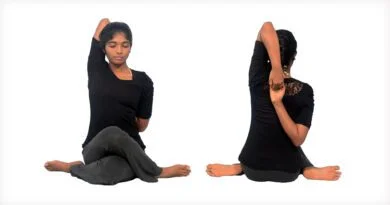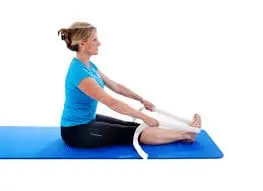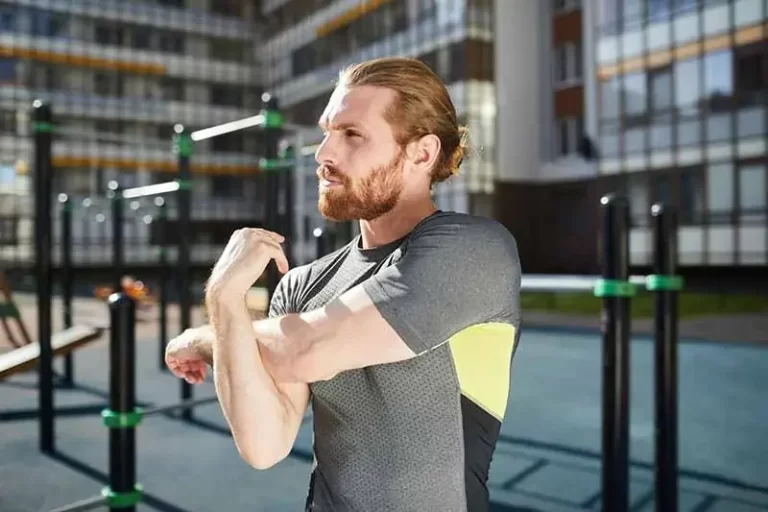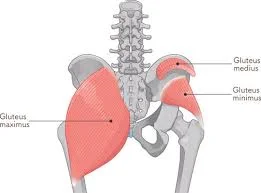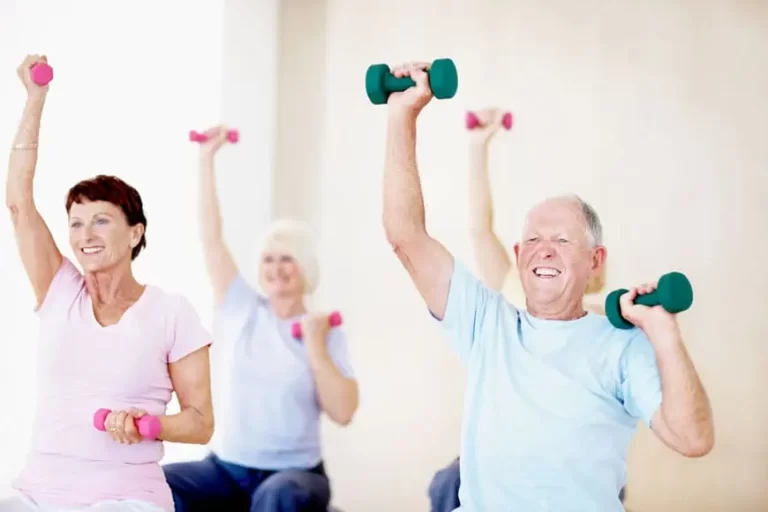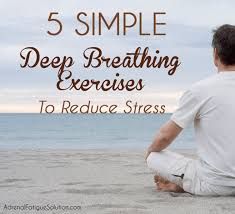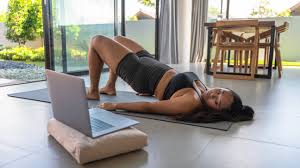Cow Face Pose (Gomukhasana)
Gomukhasana, commonly known as Cow Face Pose, is a seated yoga posture that stretches the shoulders, chest, hips, and thighs.
The name comes from the Sanskrit words Go (cow), Mukha (face), and Asana (pose), symbolizing the shape of a cow’s face formed by the arms and legs in the pose.
What Is the Cow Face Pose?
The Sanskrit term for cow face posture is Gomukhasana (pronounced go-mu-kha-suh-naa) (go — cow, mukha — face, asana — pose). The Hatha Yoga Pradipika, a classic Sanskrit manual on Hatha yoga written in the early 14th century, describes 15 positions, including this one.
For what reason is it known as the cow face pose? Your knees positioned one above the other, represent the cow’s mouth in this stance, while the elbows behind your back mimic the cow’s ears.
Which muscles are used in the cow face pose?
- Rotator cuff
- Pectoralis major and minor
- Latissimus dorsi
- rhomboids
- trapezius
- Biceps
- triceps
- forearms
- Gluteus maximus, medius, and minimus
- hip flexors
- adductors
- Quadriceps
- hamstrings
- calves
- core muscles
- Erector spinae
Benefits of the cow face pose
- increases your total posture and spine posture.
- Lung capacity increases when your intercostal muscles are stretched.
- improves the ability to breathe abdominally and diaphragmatically.
- improves stiff shoulder suppleness
- strengthens the muscles in your spine, shoulder joints, triceps, thighs, hips, and chest.
Which positions are used to prepare for the cow face pose?
- Baddha Konasana (Bound Angle Position)
- Garudasana (Eagle Position)
- Supta Baddha Konasana (Reclining Bound Angle Position)
- Supta Virasana
- Supta Padangusthasana
- Upavistha Konasana
- Virasana
- Sun Salutation (Surya Namaskar)
- Baddha Konasana (Bound Angle Position)
- Dhanurasana (Bow Position)
How to do a Cow Face Pose?
- Begin in the staff pose, or Dandasana.
- The right knee should be bent. Following flowing behind your right knee, bring your left foot to the exterior of your right hip.
- Your sitting bones are ground.
- Stretch your arms out to the sides, palms facing forward, and lengthen your spine as you take a breath.
- Turn your right shoulder inward until your thumb is pointing down and your palm is toward the wall behind you.
- Stretch your left arm upward, pointing your fingertips at the sky, while keeping the palm of your hand facing forward. If the right fingertips are within reach, hook them together by bending the elbow and reaching down for them.
- Your left elbow is now pointed upward, and your right knee is on top.
- Extend your upper body and squeeze your shoulder blades gently into your back ribs.
- Take a couple of deep breaths.
- Don’t forget to switch arms and legs. The elbow on the other side is pointing up, regardless of which knee is piled on top.
Cow face pose video:
What are the Follow-up poses for the Cow Face Pose?
Stretch your legs out in front of you to help your feet adjust after performing the Gomukhasana (Cow Face Position) exercise. Then, perform Paschimottanasana (Seated Forward Bend Position) to relieve stiffness in your lower back, hips, shoulders, and legs. The entire upper body will be stretched in this yoga pose, which will cause the muscles to fully relax.
Gomukhasana can be practiced in many different ways. Gomukhasana (Cow Face Position) can be performed with the arms in Gomukhasana (Cow Face Position with Eagle Arms), with the upper body reaching for the ground with the face (see Cow Face Position Eagle Arms Forward Twist), or with side bends while sitting in Gomukhasana (Cow Face Position Variation Side Twist). The arms and hips will become even more open with these variants.
- Purvottanasana (Upward Plank Position)
- Paschimottanasana (Seated Forward Bend)
- Dandasana (Staff Pose)
- Ardha Matsyendrasana
- Bharadvajasana
- Garudasana
- Marichyasana III
- Padmasana
- Paschimottanasana
- Upavistha Konasana
What are the Beginners tips in Cow Face Pose?
- If you have trouble getting into the pose, start on all fours and cross your legs, bringing your left knee to the inner of your right knee. Between your feet, lower your hips.
- If you have issues getting into the pose, get on fours and traverse your legs, moving your left knee to the underside of your right knee. If your vertebrae are not equally resting on the floor. Remember to maintain a long spine.
- You can practice another hip-opening stance, such as the Pigeon pose, or maintain your lower leg extended in front of you.
- Simply aim your fingertips at each other, grip your top, or use a strap if they do not meet. If you can’t reach both hands together, use your top hand to hold the strap, and your lower hand can just grab it.
What is the Breath Awareness in Cow Face Pose?
In Gomukhasana, extend your spine by inspiring and crossing your legs, bringing your feet deep into the pose. Re-inspire, extend your arms past yourself, and then release the other arm while holding onto your palms. Unstick the body with inspiration and extend farther into the pose with each exhale.
What is the Variation of Cow Face Pose?
To reap the greatest advantages, you can attempt these modifications or variants of the gomukhasana system:
- To support yourself as you move ahead, you can rest your arms in front of you, on the ground, or on your knees. You can also place your hands behind your back in an alter prayer stance.
- If you are unable to mass your knees on each other due to their rigidity, keep them removed.
- It can be utilized to balance in the position if your hips are stiff. A blanket can be used to adequately promote the off-the-floor side.
- You can alternatively perform this exercise with one leg straight out in front of you and the other bent over the top with your heel about your opposite hip if your legs are too big.
- You can fold around and conduct your breasts down to your thighs for a more contemporary version of Gomukhasana. Your shoulders, triceps, and hips will all be greatly stretched.
- Twisting forward will enhance the stretch in this position. Therefore, keep the weight on your sitting bones rather than your knees. As you inspire, come out. To help conduct your lower back into a neutral adjustment and to give your legs more room to get into the position, sit on a block.
- If you have trouble gripping your hands, use a strap to increase your reach.
The Cow Face Position (Gomukhasana) serves as the foundation for the following popular versions of the yoga pose:
- Cow Face Position
- Shoelace Position
- Cow Face Position Arms Close Up
- Half Cow Face Position Variation Forward Bend
- Cow Face Position with Eagle Arms
- Half Cow Face Position Variation
- Shoelace Position Variation Forward Bend
- Revolved Shoelace Position
- Cow Face Position Variation Side Stretch
- Cow Face Position Straps
- Cow Face Position Eagle Arms Forward Bend
What are the Types of Cow Face Pose?
- Tied Cow Face Position (Baddha Hasta Gomukhasana)
Tied Cow Face Position (Baddha Hasta Gomukhasana)
What is the Tied Cow Face Position?
The Sanskrit term Baddha Hasta Gomukhasana (Tied Cow Face Position) was translated into English as “Teased Cow Face Position.” Baddha means tied, Hasta means arm, Go means cow, and Mukh means face in Baddha Hasta Gomukhasana’s phrases.
How to Perform Tied Cow Face Position?
- Putting the left foot on the floor above the right knee while sitting in the asana position requires twisting the left leg. The right heel should be near the left buttock on the floor after bending and twisting the right leg. To ensure that the right knee rests on the left, adjust it. Place the palm on the back of the right arm after stretching it above the head and folding it. From the bottom, extend your left arm past your back. Stretch your fingers out and try to hold both hands together.
- Maintain a straight neck, head, and spine in the asana position. Apply pressure to the back of the head instead of the inside of the raised arm. Close your eyes, relax, and take regular breaths.
- Letting go of the asana position: Take a breath and bring your hands to your sides. Make sure your lower leg is facing you. Adjust the other leg to get back to a sitting position. Work out on the opposite side.
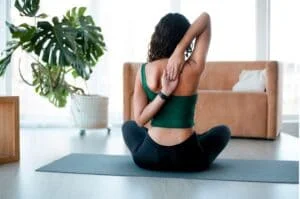
What are the Modifications in Cow Face Pose?
Let’s change this stance or find other ways to make it simpler and easier:
- The hips and lower back will experience less strain if a quality blanket is used beneath the buttocks.
- By placing a block underneath and sitting on it, you can make it simpler to overlap your thighs by putting your knees closer to the floor.
- If your elbows aren’t strong and flexible enough to keep your palms behind you so they interlock, it will help to use a yoga elastic band or strap between your hands.
- Alignment is necessary for the Cow Face Pose since it calls for a balance between the two sides of the body. It is crucial to practice on the weaker side of the body because certain poses, such as gomukhasana, can help balance the two sides.
- Holding the palms together behind you should prevent the head from falling. Make sure the collarbone and chest are in line with the chin.
- Fold one leg at a time slowly, taking care not to overlap the thighs. Start with folding only one leg and one elbow, then go to the full pose after many repetitions.
Contraindications for the Cow Face Pose
In the following situations, you should refrain from striking the cow face pose:
- If any soft tissues, such as muscles, ligaments, or tendons, have been harmed
- If either of your thighs is torn,
- If you suffer from bleeding hemorrhoids, commonly referred to as piles,
- If you have been diagnosed with spondylitis, which is another name for spine arthritis,
- If your shoulders hurt or are uncomfortable, or if your shoulder is frozen
- If you have any knee problems
What Common Errors Occur in Cow Face Pose?
- Make sure you maintain a more subdued than perverse posture.
- Avoid putting your hands together.
- Your ribs should not protrude while your hands are held.
- Instead, try to widen your lower back and lower your tailbone to the floor.
- Also, bend your upper body first, then round your back.
- Instead, spread your collarbones.
FAQs
What are the benefits of cow face pose?
increases lung capacity by extending your intercostal muscles. enhances the capacity for diaphragmatic and abdominal breathing. increases stiff shoulder suppleness. strengthens the muscles in your spine, shoulder joints, triceps, thighs, hips, and chest.
Why can’t I do a cow face pose?
When first approaching Cow Face, it could be difficult or even impossible for people with tight upper back, shoulder, and chest muscles to fully extend their arms and hands. It is best to change the pose in this situation.
Is Cow Face Pose a hip opener?
Cow Face Pose is a deep hip opener that stretches the lower body’s hamstrings, thighs, ankles, piriformis, and gluteal muscles. Because the legs are unequal, the pelvis must be carefully aligned to prevent disrupting the pelvic rhythm.
What is the spiritual meaning of the Cow Face Pose?
This is comparable to balancing creation (the root) with figuring out what this creation means to proceed on the spiritual path (the crown).
References:
- EkhartYoga. (2021, March 31). How to do Cow Face Pose or Gomukhasana – Ekhart Yoga. Ekhart Yoga. https://www.ekhartyoga.com/resources/yoga-poses/cow-face-pose
- Gomukhasana (Cow Face Pose) Modifications | Tummee.com. (n.d.). Tummee.com. https://www.tummee.com/yoga-poses/cow-face-pose/modifications
- SR, V. (2024, August 21). How to Do a Cow Face Yoga Pose. WebMD. https://www.webmd.com/fitness-exercise/how-to-do-cow-face-yoga-pose
- Mandial, D. (2024, May 22). Gomukhasana (Cow Face Pose) – Step-by-Step Guide, Benefits and Precautions. Truemeds. https://www.truemeds.in/blog/gomukhasana-step-by-step-guide-benefits-and-precautions
- Sorathiya, D. (2024, October 2). Gomukhasana (Cow Face Pose) – Benefits, How to do? Mobile Physiotherapy Clinic. https://mobilephysiotherapyclinic.in/gomukhasana-yoga-pose/

